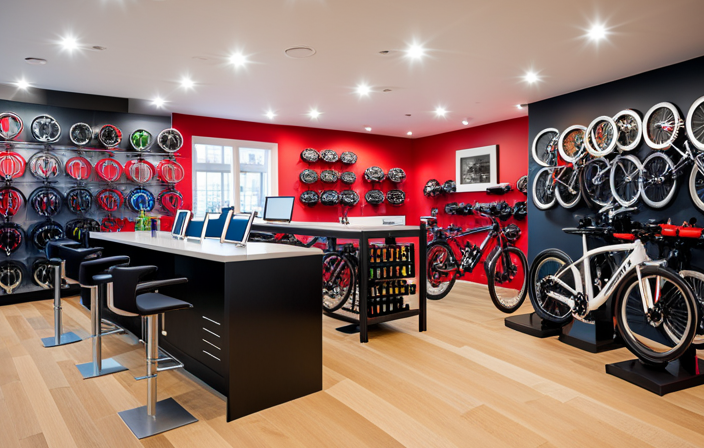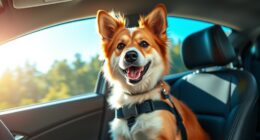Get ready to power up your ride with the electrifying technology of electric bike battery packs. These sleek and powerful devices are the beating heart of your electric bike, providing the energy needed to propel you forward with ease.
In this technical and detailed article, we will delve into the inner workings of electric bike battery packs, uncovering the secrets of how they store and release energy, exploring different types, and discussing the future of this cutting-edge technology.
So, strap on your helmet and prepare to be amazed by the wonders of electric bike battery packs.
Key Takeaways
- Electric bike battery packs are made of multiple lithium-ion cells connected in series or parallel.
- The capacity of the battery pack, measured in ampere-hours (Ah), determines the range of the bike.
- Voltage should match the motor’s requirement for compatibility and higher voltage levels result in increased power output and faster acceleration.
- Regular maintenance and care, such as cleaning, balancing charge levels, and avoiding overcharging, are necessary for the battery pack’s optimal performance and longevity.
Understanding the Basics of Electric Bike Battery Packs
If you want to understand the basics of electric bike battery packs, you’ll need to know how they work. Electric bike battery pack maintenance is essential for ensuring optimal performance and longevity.
These battery packs are typically made up of multiple lithium-ion cells connected in series or parallel to provide the necessary voltage and current for powering the electric bike. The benefits of electric bike battery packs include their portability, rechargeability, and the ability to provide consistent power output over extended periods.
Proper maintenance involves regular charging and discharging cycles, avoiding extreme temperatures, and keeping the battery pack clean and dry. Understanding the inner workings of electric bike battery packs will help you make informed decisions when it comes to choosing and maintaining your battery pack.
Moving on to the components of electric bike battery packs, let’s delve deeper into their construction and functionality.
The Components of Electric Bike Battery Packs
When assembling your e-bike battery pack, you’ll need to familiarize yourself with its key components. Proper maintenance is crucial for electric bike battery packs to ensure their optimal performance and longevity.
There are several factors to consider when choosing an electric bike battery pack. Firstly, you should evaluate the capacity of the battery, which is measured in ampere-hours (Ah), to determine its range and how far you can travel on a single charge.
Secondly, the voltage of the battery pack should match the motor’s voltage requirement to ensure compatibility.
Lastly, consider the weight and size of the battery pack, as it can affect the overall balance and maneuverability of your electric bike. Understanding these components and factors will help you make an informed decision when selecting an electric bike battery pack.
Moving forward, let’s delve into how electric bike battery packs store and release energy.
How Electric Bike Battery Packs Store and Release Energy
To store and release energy, your e-bike battery pack utilizes a complex system of cells and circuitry. The most common type of battery used in electric bikes is the lithium-ion battery pack. These battery packs offer numerous advantages, such as high energy density, lightweight design, and long lifespan. However, they also have some disadvantages, including high cost and sensitivity to extreme temperatures. Temperature plays a crucial role in the performance of electric bike battery packs. Cold weather can reduce the battery’s capacity and overall range, while excessive heat can cause damage and shorten the battery’s lifespan. It is important to keep your battery pack within the recommended temperature range to maximize its performance and longevity. In the next section, we will explore different types of electric bike battery packs, which offer various features and benefits.
| Advantages | Disadvantages | Impact of Temperature |
|---|---|---|
| High energy density | High cost | Reduced capacity |
| Lightweight design | Sensitivity to extreme temperatures | Decreased range |
| Long lifespan | Damage and shorter lifespan |
Exploring Different Types of Electric Bike Battery Packs
Take a look at the various types of e-bike battery packs available and their unique features and benefits.
There are several different battery chemistries used in electric bike battery packs, each with its own pros and cons. One common type is the lithium-ion battery, known for its high energy density and long cycle life. Another option is the lithium iron phosphate battery, which offers improved safety and thermal stability. Nickel-metal hydride batteries are less common due to their lower energy density and shorter lifespan.
When it comes to battery pack capacity and range estimation, it is important to consider factors such as the battery’s voltage, ampere-hour rating, and the power consumption of the e-bike. These factors will determine how far you can travel on a single charge.
Now, let’s explore the role of voltage in electric bike battery packs.
The Role of Voltage in Electric Bike Battery Packs
Voltage plays a crucial role in determining the power output and performance of e-bikes. The role of voltage in electric bike battery packs is significant, as it directly impacts the battery’s performance.
Here are three key ways in which voltage affects battery performance:
-
Power Output: Higher voltage levels result in increased power output, allowing the e-bike to reach higher speeds and handle steeper inclines.
-
Range: A higher voltage battery pack can provide a longer range as it can store more energy.
-
Acceleration: Voltage affects the acceleration capabilities of an e-bike. Higher voltage levels enable quicker acceleration, enhancing the overall riding experience.
Understanding the impact of voltage on battery performance is essential for choosing the right battery pack for your e-bike.
The next section will delve into the amp-hour rating and its impact on electric bike battery performance, further enhancing your knowledge in this subject.
Amp-Hour Rating and its Impact on Electric Bike Battery Performance
The amp-hour rating of a battery directly affects its performance in an e-bike. The amp-hour rating refers to the amount of current a battery can deliver over a specific period of time. A higher amp-hour rating means the battery can deliver more power and the e-bike can go for a longer distance. It is important to choose a battery with an appropriate amp-hour rating for your specific needs.
The amp-hour rating also affects the charging efficiency of the battery. A battery with a higher amp-hour rating may take longer to charge, as it requires more energy to reach its full capacity. On the other hand, a battery with a lower amp-hour rating may charge faster but may not provide as much power or range.
To better understand the impact of amp-hour rating on performance, refer to the table below:
| Amp-Hour Rating | Power Delivery | Range |
|---|---|---|
| 10 Ah | Moderate | 30 miles |
| 15 Ah | High | 45 miles |
| 20 Ah | Very High | 60 miles |
Understanding the amp-hour rating and its impact on battery performance is crucial in optimizing the performance of your e-bike. In the next section, we will discuss tips and best practices for charging electric bike battery packs, ensuring you get the most out of your battery without compromising its lifespan.
Charging Electric Bike Battery Packs: Tips and Best Practices
When charging an e-bike battery, it is important to follow these tips and best practices to optimize charging speed and maximize battery lifespan:
-
Use the charger provided by the manufacturer: Using a different charger can result in improper charging and potential damage to the battery pack.
-
Charge at the recommended voltage: Charging at a higher voltage may lead to overheating and reduced battery life, while charging at a lower voltage will result in slower charging.
-
Avoid extreme temperatures: Charging at temperatures below 0°C or above 40°C can degrade the battery’s performance and shorten its lifespan.
-
Don’t overcharge: Once the battery is fully charged, disconnect it from the charger to avoid overcharging, which can reduce battery capacity over time.
By following these tips and best practices, you can ensure that your e-bike battery charges efficiently and remains in good condition.
Now, let’s move on to maintaining and caring for electric bike battery packs.
Maintaining and Caring for Electric Bike Battery Packs
Now that you’ve learned about the best practices for charging electric bike battery packs, let’s dive into the crucial aspect of maintaining and caring for these battery packs. Battery pack maintenance is essential for maximizing battery life and ensuring optimal performance. By following a few simple guidelines, you can extend the lifespan of your electric bike battery pack and get the most out of your rides.
To help you understand the importance of battery pack maintenance, let’s take a look at the following table:
| Maintenance Task | Frequency | Description |
|---|---|---|
| Regular Cleaning | Monthly | Remove dirt and debris from the battery pack casing |
| Proper Storage | Long-term | Store the battery pack in a cool and dry place |
| Balancing Cells | Every 20-30 cycles | Equalize the charge levels of individual battery cells |
| Firmware Updates | As needed | Install the latest firmware updates for the battery pack |
By incorporating these maintenance tasks into your routine, you can ensure the longevity and efficiency of your electric bike battery pack. In the next section, we will explore ways to further extend the lifespan of your battery pack without compromising its performance.
Extending the Lifespan of Electric Bike Battery Packs
To effectively extend the lifespan of your e-bike battery pack, it’s important to implement proper maintenance and care. By following these steps, you can maximize battery performance and get the most out of your electric bike:
-
Regularly charge your battery: Avoid fully draining the battery and recharge it after each use to prevent deep discharges that can reduce its overall capacity.
-
Store your battery properly: Keep it in a cool, dry place to prevent overheating and avoid extreme temperatures that can degrade its performance.
-
Avoid overcharging: Once the battery is fully charged, unplug it to prevent overcharging, which can cause damage and reduce its lifespan.
-
Perform regular maintenance: Check for any loose connections, clean the battery terminals, and inspect for any signs of damage or wear.
By following these guidelines, you can extend the lifespan of your e-bike battery pack and maximize its performance.
Now, let’s explore the environmental impact of electric bike battery packs.
The Environmental Impact of Electric Bike Battery Packs
You can minimize the environmental impact of e-bike battery packs by implementing proper disposal methods and recycling options. Battery recycling is crucial in order to prevent the release of harmful chemicals into the environment. When disposing of an electric bike battery pack, it is important to follow local regulations and guidelines. Many countries and municipalities have designated recycling centers where you can safely drop off your old battery packs. These centers ensure that the batteries are handled and disposed of properly, minimizing the impact on the environment. Additionally, recycling also helps to recover valuable materials from the battery packs, reducing the need for new raw materials.
Another important aspect to consider is the impact of electric bike battery packs on the electric grid. As more people switch to electric bikes, the demand for charging these batteries increases. This puts strain on the electric grid, especially during peak hours. To mitigate this, it is recommended to charge your e-bike battery during off-peak hours. This helps to distribute the load on the grid more evenly and reduces the strain on the system. By following these practices, you can ensure that your e-bike battery has a minimal impact on the environment and the electric grid.
Now, let’s move on to common issues and troubleshooting for electric bike battery packs.
Common Issues and Troubleshooting for Electric Bike Battery Packs
One common issue with e-bike battery packs is their limited lifespan. Over time, the battery’s capacity gradually decreases, resulting in a shorter range and decreased performance.
To troubleshoot this issue, you can start by checking the battery’s voltage using a multimeter. If the voltage is significantly lower than the rated voltage, it may indicate a faulty cell or cells in the pack. In such cases, you can try balancing the cells or replacing the faulty ones.
Another common issue is a sudden drop in capacity, which can be caused by a faulty BMS (Battery Management System). In this case, you might need to replace the BMS to restore the battery’s performance.
Additionally, poor charging habits, extreme temperatures, and improper storage can also contribute to battery pack issues. By following proper charging and storage guidelines, you can prevent or minimize these problems.
Understanding these troubleshooting techniques can help you address common battery pack issues and ensure optimal performance.
In the next section, we will discuss upgrading and replacing electric bike battery packs.
Upgrading and Replacing Electric Bike Battery Packs
If you want to improve your e-bike’s performance, consider upgrading or replacing its battery pack.
Upgrading the battery capacity is one way to enhance your bike’s range and power. With a higher capacity battery, you can ride for longer distances without worrying about running out of juice.
Another option is to increase battery efficiency by opting for a lithium-ion battery pack. These batteries have a higher energy density and can provide more power while being lighter and smaller in size.
Additionally, upgrading to a smart battery pack with advanced features like battery management systems can optimize the performance and lifespan of your battery.
Keep in mind that when upgrading or replacing your battery pack, it is crucial to consider safety considerations.
[Transition sentence: Moving on to safety considerations for electric bike battery packs…]Safety Considerations for Electric Bike Battery Packs
When upgrading or replacing your e-bike’s battery pack, it’s important to prioritize safety considerations. Battery pack safety is crucial to prevent any potential hazards.
One of the main safety concerns is preventing overheating. Overheating can lead to battery degradation, reduced performance, or even fire hazards. To ensure safety, it is essential to choose a battery pack that has built-in protective mechanisms, such as thermal sensors and overcurrent protection. These features help regulate the temperature and prevent the battery from overheating during use.
Additionally, proper installation and maintenance are crucial in preventing overheating. Regularly inspect the battery pack for any signs of damage or wear, and avoid exposing it to extreme temperatures or moisture.
By prioritizing battery pack safety and preventing overheating, you can enjoy a safer and more reliable e-bike riding experience.
Looking ahead, the future of electric bike battery pack technology holds exciting advancements in efficiency and capacity.
The Future of Electric Bike Battery Pack Technology
The future of e-bike battery pack technology holds exciting advancements in efficiency and capacity, with potential improvements in battery life and charging speed. Advancements in battery technology are driving the development of more powerful and efficient electric bike battery packs.
These advancements will not only increase the range and power of electric bikes but also have a significant impact on transportation as a whole. With improved battery capacity, people will be able to travel longer distances on their electric bikes without worrying about running out of power. Additionally, faster charging speeds will allow riders to quickly recharge their batteries, making electric bikes a more convenient mode of transportation.
These advancements in battery technology will revolutionize the way we travel and make electric bikes a viable option for daily commuting.
Transitioning into the next section, let’s now address some frequently asked questions about electric bike battery packs.
Frequently Asked Questions about Electric Bike Battery Packs
Now that you’ve gained insight into the future of electric bike battery pack technology, let’s dive into some frequently asked questions about these remarkable power sources.
Understanding the electric bike battery pack lifespan is crucial for any electric bike enthusiast. These battery packs typically have a lifespan of around 2 to 4 years, depending on factors such as usage, charging habits, and storage conditions. It’s important to note that proper maintenance and care can extend their lifespan further.
Using electric bike battery packs comes with a plethora of benefits. Firstly, they provide a reliable and consistent power source, allowing you to travel longer distances without worrying about running out of battery. Additionally, they are eco-friendly alternatives to traditional fuel-powered vehicles, reducing carbon emissions and promoting a greener environment.
Moreover, these battery packs are lightweight and can easily be removed for charging, making them convenient and practical for everyday use.
Frequently Asked Questions
Can I use any type of charger to charge my electric bike battery pack?
Using a non-compatible charger to charge your electric bike battery pack can have detrimental effects. The charger must be specifically designed for your battery pack to ensure proper charging and avoid damage.
Using a faulty charger can lead to overcharging, undercharging, or even short-circuiting the battery pack. This can significantly reduce the battery’s lifespan and performance.
Always use the recommended charger provided by the manufacturer to ensure safe and optimal charging of your electric bike battery pack.
How long does it take to fully charge an electric bike battery pack?
The charging speed of an electric bike battery pack depends on several factors. These include the capacity of the battery pack, the charging current, and the charger’s power output. All of these factors work together to determine the overall charging time. Generally, it takes around 3 to 5 hours to fully charge an electric bike battery pack. However, it’s important to note that these charging times can vary depending on the specific battery pack and charger used.
Can I replace the battery pack in my electric bike with a higher capacity one?
Yes, you can upgrade the battery pack in your electric bike with a higher capacity one. Doing so will provide several benefits.
A higher capacity battery pack will allow you to ride for longer distances without needing to recharge. It will also provide more power and increase the overall performance of your electric bike.
Upgrading to a higher capacity battery pack is a great way to enhance your riding experience and enjoy longer, more powerful rides.
Are electric bike battery packs waterproof?
Electric bike battery packs are not always waterproof, but many manufacturers have started designing them to be water-resistant. However, it is important to note that water resistance is not the same as being fully waterproof.
Regular electric bike battery pack maintenance is crucial to prevent common issues such as water damage. It is recommended to avoid submerging the battery pack in water and to keep it protected from heavy rain or direct exposure to water to ensure its longevity.
Can I use my electric bike battery pack to charge other devices?
Yes, you can use your electric bike battery pack to charge other devices. This offers the advantage of using it as an emergency power supply when needed.
The electric bike battery pack can provide a stable power source for various devices such as smartphones, tablets, and even small appliances. Its portability and compact design make it convenient to carry and use in various situations.
It is an efficient and reliable solution for charging your devices on the go.
Conclusion
In conclusion, electric bike battery packs are an essential component of electric bikes. They provide the necessary power for a smooth and efficient ride. Battery packs store and release energy through a combination of chemical reactions and electronic components.
There are various types of battery packs available, but voltage plays a crucial role in determining the performance and range of an electric bike. Upgrading or replacing battery packs can enhance the bike’s capabilities. However, it is important to prioritize safety when handling and maintaining these packs.
Despite any concerns about battery life, advancements in technology continue to improve the efficiency and longevity of electric bike battery packs.









